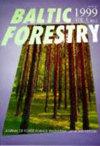21世纪波兰大波兰地区农业景观中木质线性景观要素的丧失
IF 0.6
4区 农林科学
Q3 FORESTRY
引用次数: 1
摘要
随着自然和半自然生境的丧失,农业景观中可提供的生态系统服务的多样性和数量正在减少,自我调节能力也在下降。研究的目的(72个样地- 1 x 1平方公里,平均时间跨度等于8年)是为了识别木本(乔木或灌木)线性景观元素的数量和长度的变化,以及Wielkopolska地区的孤树数量,以验证21世纪波兰农业的快速发展如何影响景观结构。分析结果表明,林分木本线性元长度下降了9.3%(从2.17 km/km2下降到1.97 km/km2),林分木本线性元数量下降了7.4%(从16.5 km/km2下降到15.0 km/km2),林分木本线性元数量下降了14.6%(从28.8 km/km2下降到24.4 km/km2)。在放宽树木和灌木砍伐规定期间(2017-2018年),树木和灌木的砍伐速度明显加快,这主要是由于位于城市化景观中的地块的砍伐率很高。木本线性元的长度在研究中所划分位置的所有类别中都出现了减少(每个类别减少9-41%)。损失最大的是位于改良沟渠和河道、道路沿线和城镇郊区的木质线形要素。这些变化与20世纪西欧发生的变化相似。木本线性景观要素和孤树数量的减少可视为农业管理不可持续的一个指标。本文章由计算机程序翻译,如有差异,请以英文原文为准。
The loss of woody linear landscape elements in agriculture landscape in Wielkopolska region (Poland) in 21th century
With the loss of natural and semi-natural habitats, the diversity and the amount of ecosystem services that can be provided in the agricultural landscape are diminishing, and self-regulatory abilities decrease. The aim of the research (72 sample plots – 1 x 1 km squares, mean time span equal to 8 years) was to recognise the changes in the number and length of woody (tree or shrub) linear landscape elements, and the number of solitary trees in the Wielkopolska region to verify how rapid development of agriculture in Poland in the 21st century affects the landscape structure. The analyses show a decline by 9.3% (from 2.17 to 1.97 km/km2) in length of woody linear elements, 7.4% (from 16.5 to 15.0 per km2) in number of woody linear elements, and 14.6% (from 28.8 to 24.4 per km2) in solitary trees. The loss was significantly faster in the period (2017-2018) of liberalisation of the regulations on tree and shrub removal, mainly due to a high rate of removal in plots located in an urbanized landscape. The decrease in length of woody linear elements occurred in all the categories of their location distinguished in the study (by 9-41% in a category). The highest loss occurred in the woody linear elements located along melioration ditches and water courses, along roads, and in the outskirt of towns. These changes are similar to those occurring in the 20th century in western Europe. The decrease in the number of woody linear landscape elements and solitary trees can be considered an indicator of the unsustainable agriculture management.
求助全文
通过发布文献求助,成功后即可免费获取论文全文。
去求助
来源期刊

Baltic Forestry
农林科学-林学
CiteScore
1.60
自引率
0.00%
发文量
23
审稿时长
>12 weeks
期刊介绍:
The journal welcomes the original articles as well as short reports, review papers on forestry and forest science throughout the Baltic Sea region and elsewhere in the area of boreal and temperate forests. The Baltic Sea region is rather unique through its intrinsic environment and distinguished geographical and social conditions. A temperate climate, transitional and continental, has influenced formation of the mixed coniferous and deciduous stands of high productivity and biological diversity. The forest science has been affected by the ideas from both the East and West.
In 1995, Forest Research Institutes and Universities from Estonia, Latvia and Lithuania
joined their efforts to publish BALTIC FORESTRY.
 求助内容:
求助内容: 应助结果提醒方式:
应助结果提醒方式:


